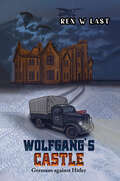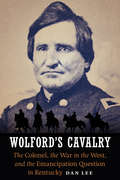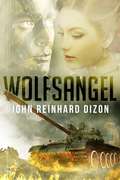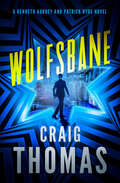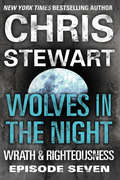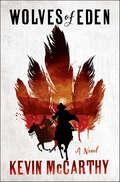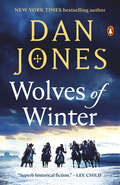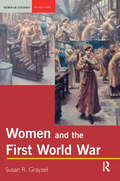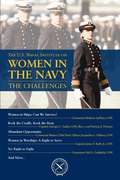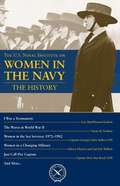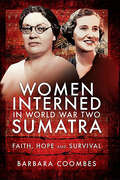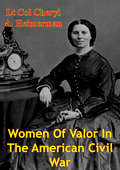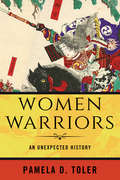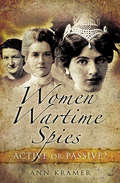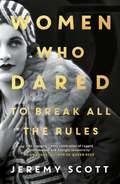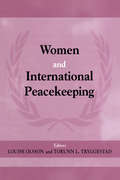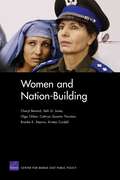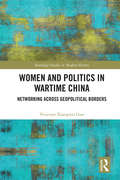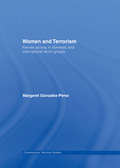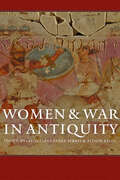- Table View
- List View
Wolfgang's Castle: Germans against Hitler
by Rex W LastAmidst the secluded valleys of Bavaria, 1940, lies a covert Nazi stronghold, the womb to the sinister Project Sea Eagle. Here, in hidden chambers beneath the earth, Nazi scientists toil over an innovative menace: a fleet of aqua-planes intended to unleash a torrent of terror upon Britain’s shores once more. Against the dark tide rises a band of unlikely allies: four anti-Nazi Germans, two audacious SOE operatives, and twenty captive RAF officers. With scarce resources yet unyielding resolve, they plot to dismantle this aquatic harbinger of invasion. At the heart of their mission lies the experimental ‘aquaplane,’ a swift maritime vessel conceived to ferry troops and weaponry across the Channel, a dire threat to England’s already beleaguered coast. The citadel of Sea Eagle, veiled beneath the earth, eludes the reach of aerial bombs, and a direct military assault is a gambit Britain can ill afford. Amidst the storm of war, Major Archie Wellings of the SOE forms a daring coalition with two German couples and others, orchestrating a clandestine assault on Wolfgang’s Castle, the nexus of Sea Eagle. They turn Nazi ideology against itself, employing ingenious subterfuges to thwart the looming peril. Wolfgang’s Castle is more than a tale of espionage and warfare. It delves into the essence of patriotism, the indomitable spirit of resistance, and the unexpected corridors of camaraderie amidst the horrors of war. With a sprinkle of satire, a glimpse into wartime’s gender dynamics, and a tender vein of romance, this thrilling narrative is not just a journey through the shadows of war, but a venture into the myriad shades of human valour and ingenuity.
Wolford's Cavalry: The Colonel, the War in the West, and the Emancipation Question in Kentucky
by Dan LeeColonel Frank Wolford, the acclaimed Civil War colonel of the First Kentucky Volunteer Cavalry, is remembered today primarily for his unenviable reputation. Despite his stellar service record and widespread fame, Wolford ruined his reputation and his career over the question of emancipation and the enlistment of African Americans in the army. Unhappy with Abraham Lincoln’s public stance on slavery, Wolford rebelled and made a series of treasonous speeches against the president. Dishonorably discharged and arrested three times, Wolford, on the brink of being exiled beyond federal lines into the Confederacy, was taken in irons to Washington DC to meet with Lincoln. Lincoln spared Wolford, however, and the disgraced colonel returned to Kentucky, where he was admired for his war record and rewarded politically for his racially based rebellion against Lincoln. Although his military record established him as one of the most vigorous, courageous, and original commanders in the cavalry, Wolford’s later reputation suffered. Dan Lee restores balance to the story of a crude, complicated, but talented man and the unconventional regiment he led in the fight to save the Union. Placing Wolford in the context of the political and cultural crosscurrents that tore at Kentucky during the war, Lee fills out the historical picture of “Old Roman Nose.”
Wolfpack Hunting MiGs over Vietnam
by Jerry ScuttsAir-to-air combat was limited in Vietnam compared to the Korean or Second World wars. The author does a credible job of examining the air combat that did take place, examining the tactics, equipment, and the personnel of both sides.
Wolfsangel
by Jonay Quintero Hernández John Reinhard DizonDespués de que el comando Carl Hansen fuese traído de vuelta desde las congeladas estepas de la Rusia Occidental para luchar en la invasión aliada de Normandía en 1944, su relación amorosa con la heredera francesa Angelique Dagineau se convertirá en su única razón para sobrevivir a la apocalíptica batalla que tiene por delante. Mientras la Resistencia francesa se alza por todo el sur de Francia para evitar que la división se una al combate, la tupida red de intrigas entre las fuerzas del corrupto gobierno de Vichy, la mafia parisina y los insurgentes comunistas comienza a desvelarse. Cuando Carl se entera de que Angelique ha desaparecido e incluso peor, que podría ser el objetivo de una masiva cacería humana de la Gestapo, se embarca en una misión para rescatarla que le lleva al corazón mismo del peligro y más allá. Wolfsangel de John Reinhard Dizon es un trabajo que no deben perderse los aficionados a las novelas históricas de la Segunda Guerra Mundial, las historias de acción y las novelas románticas por igual.
Wolfsbane (The Kenneth Aubrey & Patrick Hyde Series)
by Craig ThomasYears after a shattering wartime betrayal, an ex-agent embarks on a quest for revenge in this powerful thriller by the New York Times–bestselling author . . . Nineteen years ago, Richard Gardiner was a British agent who was captured and tortured by the Gestapo after a bitter betrayal. Now, during a visit to France, he sees a face that triggers his rage—and his thirst for revenge. All that he learned from his former career in espionage will be put to use as he sets out on a murderous new mission. Meanwhile, MI6 chief Kenneth Aubrey is on his own hunt for a double agent inside the NATO Senior Joint Intelligence Committee. As both men pursue their targets, secrets will be revealed—and blood will be spilled . . . &“Classic espionage.&” —The London Times &“Machinations within machinations.&” —The New York Times
Wolves in the Night (Wrath & Righteousness #Episode Seven)
by Chris StewartFive days ago an EMP attack brought the most technologically advanced country on Earth to its knees. Cars were useless. Phones were dead. Electricity was only a memory. <p><p> Those who survived the initial assault now faced an even more desperate situation: mobs of angry, violent people with nothing to do. No food, water or medicine. Evil spreading through the masses as though it were an infectious disease. <p> As Americans struggle to survive, so does the country itself. With the President and Vice President killed in the attack, the line of succession itself becomes a target--creating a power vacuum in Washington and leaving the country vulnerable to final, devastating attack. <p> Against the backdrop of torn-from-the-headlines Middle Eastern drama, the Wrath & Righteousness series is a fast-paced thriller that explores man's role in the eternal battle between good and evil.
Wolves of Eden: A Novel
by Kevin McCarthy“Kevin McCarthy is in the company of masters like Patrick O’Brian and Hilary Mantel.… [A] shiningly humane novel.” —Stephen Harrigan, author of The Gates of the Alamo and A Friend of Mr. Lincoln1866, Dakota Territory. Red Cloud’s coalition of tribes is battling the U.S. Army to reclaim hunting grounds in the Powder River Valley. Against this background, Wolves of Eden sets four men on a deadly collision course in a narrative that explores the cruelty of warfare, the power of love and the resilience of the human spirit. Lieutenant Martin Molloy and his loyal orderly are sent west to investigate a triple murder at a frontier fort, and Irish immigrant brothers Thomas and Michael O’Driscoll, who survived the brutal frontlines of the Civil War, find themselves as both hunters and the hunted in another bloody campaign. Blending intimate historical detail and emotional acuity, Wolves of Eden is “a riveting and propulsive mystery” (Publishers Weekly).
Wolves of Winter: A Novel (Essex Dogs Trilogy #2)
by Dan Jones"Superb historical fiction, as fresh, vivid and vital as this morning's headlines ... proves once again that nothing really changes, be it a soldier's life - or great storytelling."—Lee ChildAN ENDLESS WAR.A BLOOD-SOAKED BATTLEFIELD.A BAND OF BROTHERS.The epic sequel to Essex Dogs, continuing the New York Times bestselling historian's trilogy of novels following the fortunes of ten ordinary soldiers during the Hundred Years War.1347. Bruised and bloodied by an epic battle at Crécy, six soldiers known as the Essex Dogs pick through the wreckage of the fighting—and their own lives. Now a new siege is beginning, and the Dogs are sent to attack the soaring walls of Calais. King Edward has vowed no Englishman will leave France &‘til this city falls. To get home, they must survive a merciless winter in a lawless camp deadlier than any battlefield. Obsessed with tracking down the vanished Captain, Loveday struggles to control his own men. Romford is haunted by the reappearance of a horrific figure from his past. And Scotsman is spiraling into a pit of drink, violence, and self-pity. The Dogs are being torn apart—but this war is far from over. It won't be long before they lose more of their own. From a vast siege camp built outside Calais' walls, to the pirate ships patrolling the harbor, and into the dark corners of oligarchs' houses, where the deals that shape—and end—lives are made, this captivating and darkly comic story brings the fourteenth century vividly to life.
Woman on Fire: A Novel
by Lisa Barr“An exuberant and propulsive thriller laced with sex, art, and history. Lisa Barr has created an unforgettable story that forces readers to question where the line should be drawn between the pursuit of justice and the hunt for revenge.”—Alyson Richman, bestselling author of The Secret of CloudsFrom the author of the award-winning Fugitive Colors and The Unbreakables, a gripping tale of a young, ambitious journalist embroiled in an international art scandal centered around a Nazi-looted masterpiece—forcing the ultimate showdown between passion and possession, lovers and liars, history and truth.After talking her way into a job with Dan Mansfield, the leading investigative reporter in Chicago, rising young journalist Jules Roth is given an unusual—and very secret—assignment. Dan needs her to locate a painting stolen by the Nazis more than 75 years earlier: legendary Expressionist artist Ernst Engel’s most famous work, Woman on Fire. World-renowned shoe designer Ellis Baum wants this portrait of a beautiful, mysterious woman for deeply personal reasons, and has enlisted Dan’s help to find it. But Jules doesn’t have much time; the famous designer is dying.Meanwhile, in Europe, provocative and powerful Margaux de Laurent also searches for the painting. Heir to her art collector family’s millions, Margaux is a cunning gallerist who gets everything she wants. The only thing standing in her way is Jules. Yet the passionate and determined Jules has unexpected resources of her own, including Adam Baum, Ellis’s grandson. A recovering addict and brilliant artist in his own right, Adam was once in Margaux’s clutches. He knows how ruthless she is, and he’ll do anything to help Jules locate the painting before Margaux gets to it first.A thrilling tale of secrets, love, and sacrifice that illuminates the destructive cruelty of war and greed and the triumphant power of beauty and love, Woman on Fire tells the story of a remarkable woman and an exquisite work of art that burns bright, moving through hands, hearts, and history.
Women And The First World War
by Susan R. GrayzelThe First World War was the first modern, total war, one requiring the mobilisation of both civilians and combatants. Particularly in Europe, the main theatre of the conflict, this war demanded the active participation of both men and women. <p><p> Women and the First World War provides an introduction to the experiences and contributions of women during this important turning point in history. In addition to exploring women’s relationship to the war in each of the main protagonist states, the book also looks at the wide-ranging effects of the war on women in Africa Asia, Australia, New Zealand, and North America. <p> Containing a document section providing a wide range of sources from first-hand accounts, a Chronology and Glossary, Women and the First World War is an ideal text for students studying the First World War or the role of women in the twentieth century.
Women Heroes of the American Revolution: 20 Stories of Espionage, Sabotage, Defiance, and Rescue
by Susan CaseyA commemoration of the brave yet largely forgotten women who served in America's War of Independence Every schoolchild knows about Paul Revere's 20-mile ride to warn that the British were coming. Far fewer know that 16-year-old Sybil Ludington rode twice as far on her horse Star in order to help her father, Colonel Ludington, muster his scattered troops to fight a marauding enemy. Few know about Martha Bratton, who blew up a supply of gunpowder to keep it from approaching British troops and boldly claimed, "It was I who did it!" Susan Casey gives Ludington, Bratton, and 18 other remarkable girls and women the spotlight they deserve in this lively collection of biographical profiles. These women took action in many ways: as spies, soldiers, nurses, water carriers, fundraisers, writers, couriers, and more. Women Heroes of the American Revolution brings a fresh new perspective to their stories resulting from interviews with historians and with descendants of participants of the Revolution and features ample excerpts from primary source documents. Also included are contextualizing sidebars, images, source notes, and a bibliography, making this an invaluable resource for any student's or history buff's bookshelf.
Women In The Navy: The Challenges
by Thomas J. CutlerThe U. S. Naval Institute Chronicles series focuses on the relevance of history by exploring topics like significant battles, personalities, and service components. Tapping into the U. S. Naval Institute's robust archives, these carefully selected volumes help readers understand nuanced subjects by providing unique perspectives and some of the best contributions that have helped shape naval thinking over the many decades since the Institute’s founding in 1873. Serving as a companion to the history of women in the Navy, this volume presents the challenges that have accompanied the long road to gender integration. In these pages readers will find edification, clarification, and much food for thought about one of the most significant national defense issues of modern times.
Women In The Navy: The History
by Thomas J. CutlerThe U. S. Naval Institute Chronicles series focuses on the relevance of history by exploring topics like significant battles, personalities, and service components. Tapping into the U. S. Naval Institute's robust archives, these carefully selected volumes help readers understand nuanced subjects by providing unique perspectives and some of the best contributions that have helped shape naval thinking over the many decades since the Institute’s founding in 1873. Meeting the challenges of gender integration has been a "joint” operation that has encompassed all of the armed forces. This edition of Naval Institute Chronicles tells a significant portion of the evolutionary and revolutionary transition from the days of "yeomanettes” to today’s Navy--where women command ships and wear admirals’ stars.
Women Interned in World War Two Sumatra: Faith, Hope and Survival
by Barbara CoombesThousands of women and children were among those who struggled to leave Singapore just before capitulation on February 15 1942; their hope was to reach safety. For many that hope was never realised; countless numbers drowned as ships were bombed and sunk on their way to ‘safety’. The ‘lucky’ ones who survived the onslaught of the ships would become guests of the Japanese; many of these would not live to see the end of the war. Two very different women fleeing on those last ships and subsequently interned in camps throughout Sumatra were Margaret Dryburgh, a missionary and teacher, and Shelagh Brown, a secretary at the Singapore Naval Base. Their paths crossed briefly prior to the catastrophic events of 1942 and met again in internment. The ‘Captives Hymn’ composed by Margaret Dryburgh was initially sung by herself along with Shelagh Brown and friend Dorothy MacLeod on 5 July 1942. It has since been sung at services throughout internment and continues to be sung at services all over the world. Music and faith were fundamental to both their lives and Margaret’s creative talents lifted the spirits of everyone during those dark and difficult days. In a remarkable partnership, when the women were struggling to find something new that would lift their flagging spirits, Margaret and fellow internee Norah Chambers produced a ‘Vocal Orchestra’ using women’s voices in place of instruments. The first performance stunned the entire camp; they had never heard anything so beautiful and momentarily made them feel that they were free and floating away with the music. This true account, using personal diaries and family documents traces Margaret Dryburgh and Shelagh Brown’s journey from childhood through to adulthood and internment. Early life shapes adult life and perhaps contributed to their response to captivity which showed courage, tenacity, perseverance and surprisingly, given the appalling conditions, a good deal of humour. ‘May the Day of Freedom Dawn’
Women Of Valor In The American Civil War
by Lt Col Cheryl A. Heimerman USAFThe role of women in the Civil War has often been overlooked in history. Women's roles prior to the Civil War were primarily confined to the home and family. Single women or those who were financially challenged could find work outside the home but opportunities were limited. At the outset of the war, more women were forced into working in factories or for the government, not only to support the war effort but also to provide for the family when the husband was at war. Many women who stayed home also became the nucleus for the formation of ladies aids societies, gathering supplies and raising funds for the soldiers.Other women chose a more direct involvement in the war. These women, including daughters of the regiment, vivandières, militia members, spies, saboteurs, soldiers, nurses and doctors, proved that women could be aggressive, resourceful and patriotic. While little has been written about their contributions, in recent years more research has brought their stories to the forefront. By selecting a representative sampling of women in each category, a better understanding of women's changing roles was revealed.Since many of the roles of women during the Civil War were a departure from those considered traditional at the time, it is important to consider how these changing roles impacted life for women after the war ended. History shows both positive and negative impacts in areas such as careers and education, however, virtually no progress was made for the role of women in the military.
Women Warriors and Wartime Spies of China
by Louise EdwardsIn this compelling new study, Louise Edwards explores the lives of some of China's most famous women warriors and wartime spies through history. Focusing on key figures including Hua Mulan, Zheng Pingru and Liu Hulan, this book examines the ways in which these extraordinary women have been commemorated through a range of cultural mediums including film, theatre, museums and textbooks. Whether perceived as heroes or anti-heroes, Edwards shows that both the popular and official presentation of these women and their accomplishments has evolved in line with China's shifting political values and circumstances over the past one hundred years. Written in a lively and accessible style with illustrations throughout, this book sheds new light on the relationship between gender and militarisation and the ways that women have been exploited to glamorise war both historically in the past and in China today.
Women Warriors: An Unexpected History
by Pamela D. TolerWho says women don't go to war? From Vikings and African queens to cross-dressing military doctors and WWII Russian fighter pilots, these are the stories of women for whom battle was not a metaphor.The woman warrior is always cast as an anomaly--Joan of Arc, not GI Jane. But women, it turns out, have always gone to war. In this fascinating and lively world history, Pamela Toler not only introduces us to women who took up arms, she also shows why they did it and what happened when they stepped out of their traditional female roles to take on other identities. These are the stories of women who fought because they wanted to, because they had to, or because they could. Among the warriors you'll meet are * Tomyris, ruler of the Massagetae, who killed Cyrus the Great of Persia when he sought to invade her lands * The West African ruler Amina of Hausa, who led her warriors in a campaign of territorial expansion for more than 30 years * Boudica, who led the Celtic tribes of Britain into a massive rebellion against the Roman Empire to avenge the rapes of her daughters * The Trung sisters, Trung Trac and Trung Nhi, who led an untrained army of 80,000 troops to drive the Chinese empire out of Vietnam * The Joshigun, a group of 30 combat-trained Japanese women who fought against the forces of the Meiji emperor in the late 19th century * Lakshmi Bai, Rani of Jhansi, who was regarded as the "bravest and best" military leader in the 1857 Indian Mutiny against British rule * Maria Bochkareva, who commanded Russia's first all-female battalion--the First Women's Battalion of Death--during WWII * Buffalo Calf Road Woman, the Cheyenne warrior who knocked General Custer off his horse at the Battle of Little Bighorn * Juana Azurduy de Padilla, a mestiza warrior who fought in at least 16 major battles against colonizers of Latin America and who is a national hero in Bolivia and Argentina today * And many more spanning from ancient times through the 20th century.By considering the ways in which their presence has been erased from history, Toler reveals that women have always fought--not in spite of being women but because they are women.
Women Wartime Spies: Active or Passive?
by Ann Kramer&“A thrilling, challenging and educational book . . . examines the roles of spies such a Edith Cavell, Mata Hari, Violette Szabo and Noor Inayat Khan&” (Pennant Magazine). Women spies have rarely received the recognition they deserve. They have often been trivialized and, in cinema and popular fiction, stereotyped as vamps or dupes. The reality is very different. As spies, women have played a critical role during wartime, receiving and passing on vital information, frequently at considerable risk. Often able to blend into their background more easily than their male counterparts, women have worked as couriers, transmitters, and with resistance fighters, their achievements often unknown. Many have died. Ann Kramer describes the role of women spies during wartime, with particular reference to the two world wars. She looks at why some women chose to become spies, their motives, and backgrounds. She looks at the experience of women spies during wartime, what training they received, and what skills they needed. She examines the reality of life for a woman spy, operating behind enemy lines, and explores and explodes the myths about women spies that continue until the present day. The focus is mainly on Britain but also takes an international view as appropriate. &“Tells the often surprising stories of some of the women who chose to become spies and to serve their country . . . An excellent work.&” —The Great War Magazine
Women Who Dared: To Break All the Rules
by Jeremy ScottVictoria Woodhull, Mary Wollstonecraft, Aimee Semple McPherson, Edwina Mountbatten, Margaret Argyll and Chanel were all women who dared. They had no time for what society said they could and couldn&’t do and would see the world bend before they did. In 1872 a mesmerising psychic named Victoria Woodhull shattered tradition by running for the White House. Had she won the ensuing spectacle would surely have rivalled that of our own era. Abhorring such flamboyance, Mary Wollstonecraft inspired a revolution of thought with her pen as she issued women&’s first manifesto – still to be fulfilled. From Aimee Semple McPherson, the first female preacher in America, to Coco Chanel, designer of an empire, these women became the change they wanted to see in society. In Women Who Dared, Jeremy Scott pays tribute to them all with wit, verve and reverence.
Women and International Peacekeeping
by Louise Olsson; Torunn L. TryggestadThis volume deals with women's participation in international peacekeeping operations and what those operations might consider to be the role and circumstances of women, including those of the host society. Essays include: a theoretical perspective on women and war, highlighting the difference between post-modernist and universalist approaches to women's roles in peacemaking and conflict resolution, the role of women in military operations, the implications of the high levels of sexual violence in peacekeeping operations and the UN's gender policy for peacekeeping operations.
Women and Nation-Building
by Cheryl Benard Olga Oliker Seth G. Jones Brooke Stearns Lawson Cathryn Quantic ThurstonUsing a case study of Afghanistan, this study examines gender-specific impacts of conflict and post-conflict and the ways they may affect women differently than they affect men. It analyzes the role of women in the nation-building process and considers outcomes that might occur if current practices were modified. Recommendations are made for improving data collection in conflict zones and for enhancing the outcomes of nation-building programs.
Women and Political Violence: Female Combatants in Ethno-National Conflict (Contemporary Security Studies)
by Miranda AlisonThis book directly challenges the stereotype that women are inherently peaceable by examining female combatants’ involvement in ethno-national conflicts. Drawing upon empirical case studies of Sri Lanka and Northern Ireland, this study explores the ways in which women have traditionally been depicted. Whereas women have predominantly been seen as victims of conflict, this book acknowledges the reality of women as active combatants. Indeed, female soldiers/irregulars are features of most modern conflicts, and particularly in ethno-nationalist violence – until now largely ignored by mainstream scholarship. Original interview material from the author’s extensive fieldwork addresses why, and how, some women choose to become violently engaged in nationalist conflicts. It also highlights the personal / political costs and benefits incurred by such women. This book provides a valuable insight into female combatants, and is a significant contribution to the literature. This book will be of great interest to students of political violence, ethnic conflict, gender studies and international relations in general.
Women and Politics in Wartime China: Networking Across Geopolitical Borders (Routledge Studies in Modern History)
by Vivienne Xiangwei GuoFocusing on Chinese elite women as a special socio-political group, this book places the sophisticated networks they formed in the shifting geographical, social, cultural and political spaces of wartime China, where their political engagement, knowledge-making, and network-building in support of 'national resistance and reconstruction' (kangzhan jianguo) unfolded. By examining the emergence, development, integration, and transformation of these networks as an unsettled, fragmented process - a process that lasted through the extended wars and upheavals in China from the 1930s to the 1950s and that moves beyond party ideologies and geopolitical borders, the book seeks to explore the dynamics of war, politics, and gender in the broader context of the Second World War.
Women and Terrorism: Female Activity in Domestic and International Terror Groups (Contemporary Terrorism Studies)
by Margaret Gonzalez-PerezThis book examines the relationship between women and terrorist activities in the post-World War II era. Utilizing comparative research into 26 terrorist organizations world-wide, the work identifies a dichotomy whereby women are significantly more active in domestic terrorist organizations than in international groups. Women and Terrorism argues that domestic terrorist organisations employ revolution, secession, or other means to change internal aspects of the state and the social and economic structure it maintains. This offers the possibility of change in women's societal status; therefore, women are drawn to domestic terrorist organizations in much higher proportions and choose a much greater level of activity, entering the ranks of combat, leadership, and policymaking. By contrast, international terrorist groups oppose outside forces, such as imperialism, capitalism, Western culture, or other more nebulous concepts. Gonzalez-Perez argues that female lack of participation in these activities reflects the fact that women will be relegated to the status quo, regardless of the success or failure of the international terrorist movement.
Women and War in Antiquity
by Jacqueline Fabre-Serris and Alison KeithWomen in ancient Greece and Rome played a much more active role in battle than previously assumed.The martial virtues—courage, loyalty, cunning, and strength—were central to male identity in the ancient world, and antique literature is replete with depictions of men cultivating and exercising these virtues on the battlefield. In Women and War in Antiquity, sixteen scholars reexamine classical sources to uncover the complex but hitherto unexplored relationship between women and war in ancient Greece and Rome. They reveal that women played a much more active role in battle than previously assumed, embodying martial virtues in both real and mythological combat.The essays in the collection, taken from the first meeting of the European Research Network on Gender Studies in Antiquity, approach the topic from philological, historical, and material culture perspectives. The contributors examine discussions of women and war in works that span the ancient canon, from Homer’s epics and the major tragedies in Greece to Seneca’s stoic writings in first-century Rome. They consider a vast panorama of scenes in which women are portrayed as spectators, critics, victims, causes, and beneficiaries of war.This deft volume, which ultimately challenges the conventional scholarly opposition of standards of masculinity and femininity, will appeal to scholars and students of the classical world, European warfare, and gender studies.
